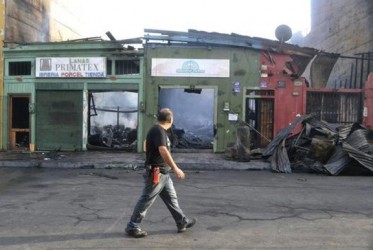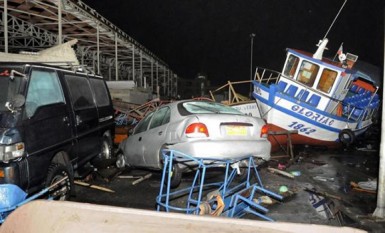SANTIAGO, (Reuters) – Chilean authorities yesterday were assessing the damage from a massive earthquake that struck off the northern coast, causing a small tsunami, but the impact appeared to be mostly limited.

The 8.2 magnitude quake that shook northern Chile on Tuesday killed six people and triggered a tsunami with 2-meter (7-foot) waves.
As the ocean waves receded, over 900,000 people who had evacuated the country’s low-lying coastal areas returned to their homes, some to find their houses and livelihoods in ruins. More than 2,600 homes were damaged and fishing boats along the northern coast were smashed up. However, most infrastructure held up and mines in the world’s No. 1 copper producer were generally functioning normally.
The arid, mineral-rich north is sparsely populated, with most of the population concentrated in the port towns of Iquique and Arica, near the Peruvian border.
In Peru, the earthquake led to temporary power outages and evacuations in some southern towns, but did not cause serious damage or injuries.
Chilean President Michelle Bachelet visited Iquique yesterday and praised people’s orderly response to the emergency.

“We are here to recognize the calm behavior of the people of Iquique who showed great civic responsibility, as did those of Arica. I think you have given us all a tremendous example,” she said.
The government would put great effort into restoring services, she added.
Finance Minister Alberto Arenas said the government would place “no limit on the use of resources to address this emergency.”
Bachelet, who was sworn in as president less than a month ago, is likely conscious of the stinging criticism she faced near the end of her first term in office in 2010, when the government was seen to have responded inadequately to a much bigger 8.8 quake and tsunami that killed over 500 people.
DAMAGE LIMITED
It was too early to estimate financial losses, but they were expected to be much lower than the $30 billion from the 2010 quake, which affected the more densely populated central region, said earthquake expert Alexander Allmann at reinsurer Munich Re.
“The quake has caused severe damage to some buildings in the affected region, but in general the building standards in Chile are comparatively high, allowing buildings and infrastructure to withstand such quakes reasonably well,” said Allmann.
“The small tsunami triggered by the quake is not expected to have caused significant damage.”
Small fishing vessels in the ports appeared to be among the worst affected.
“We struggled just to be able to get a bigger boat… and now look at it,” a woman from Iquique’s fishing community, in tears, said in a video posted on Reuters.com.
Several smaller aftershocks, some as big as 5.2 magnitude, continued into Wednesday and some ports in the area remained closed.
Landslides also blocked eight roads and Iquique’s hospital suffered some damage but otherwise most infrastructure was in good shape, emergency office Onemi said. Nearly 300 prisoners took advantage of the emergency on Tuesday night to escape from a female penitentiary in Iquique. About 130 had since voluntarily returned, Onemi said.
The global price for copper initially jumped on news of the quake, but market reaction was otherwise muted, with Chile’s IPSA stock market closing up 0.4 percent on Wednesday. Shares in local cement makers Melon and Cementos Bio-Bio rose on expectations of higher demand.
THE BIG ONE
Chileans live in one of the most earthquake-prone areas of the world. In 1960, southern Chile was hit by a 9.5 quake, the largest in modern history.
Residents in the area of the latest quake have been expecting “the big one” for many years. The Nazca and South American tectonic plates rub up against each other just off the coast of Iquique, where a “seismic gap” has been building up.

